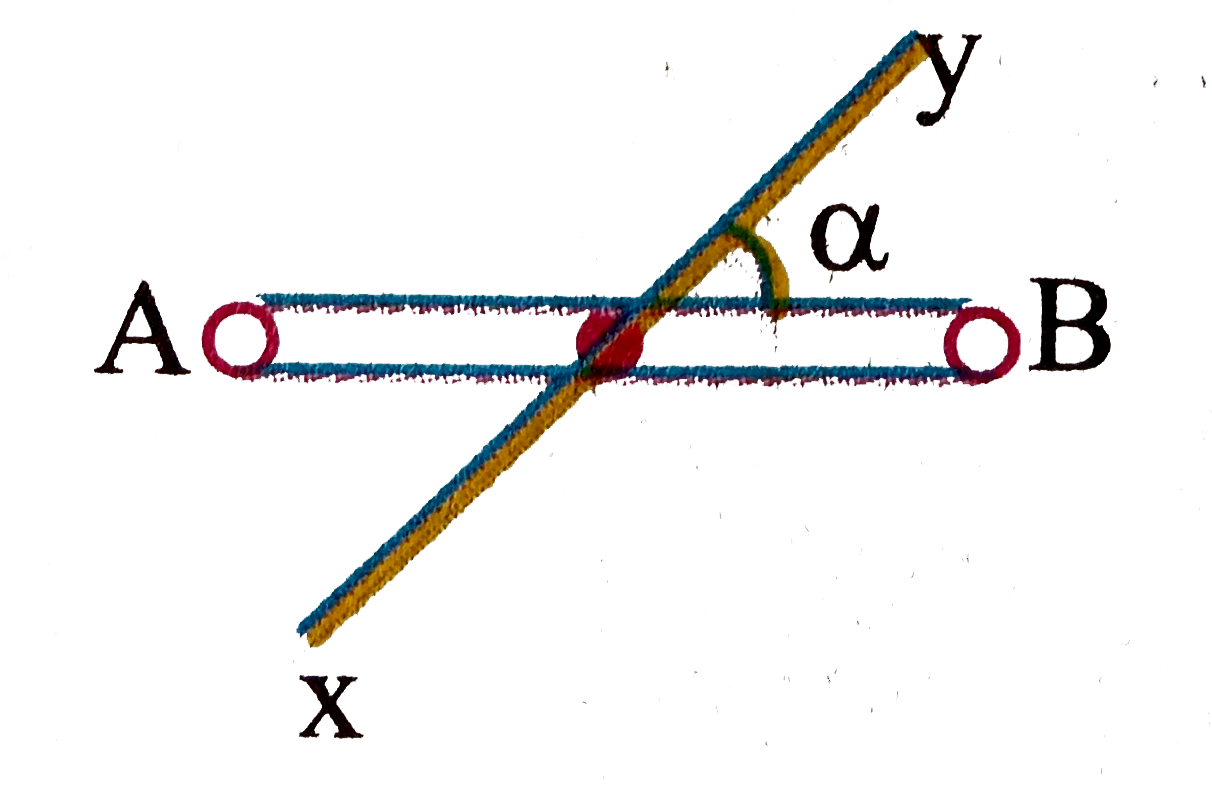What will be the breaking strength of the material if a horizontal rod of density ρ and length unity, which is rotating about a vertical axis (passing through its centre ), ruptures at 10 rps.
To find the breaking strength of the material of a horizontal rod rotating about a vertical axis, we can follow these steps:
Step 1: Determine the Angular Speed
Given that the rod rotates at a frequency of 10 revolutions per second (rps), we can convert this to angular speed (ω) using the formula:
ω=2πf
Substituting the given frequency:
ω=2π×10=20π rad/s
Step 2: Define an Element of the Rod
Consider an infinitesimal element of the rod at a distance x from the center. The length of the rod is unity (1 unit), so we can define an elemental length dx.
Step 3: Calculate the Mass of the Element
The mass dm of the elemental length dx can be expressed as:
dm=ρ⋅A⋅dx
where A is the cross-sectional area of the rod and ρ is the density.
Step 4: Determine the Velocity of the Element
The velocity V of the elemental mass at distance x from the center is given by:
V=ωx
Substituting the value of ω:
V=(20π)x
Step 5: Calculate the Centripetal Force on the Element
The centripetal force dFc acting on the mass dm is given by:
dFc=dm⋅V2x
Substituting for dm and V:
dFc=ρAdx⋅(20πx)2x=ρAdx⋅400π2x
Thus, we have:
dFc=400π2ρAxdx
Step 6: Integrate to Find the Total Centripetal Force
To find the total centripetal force Fc acting on the rod, we integrate dFc from 0 to L/2 (where L=1):
Fc=∫1/20400π2ρAxdx
Calculating the integral:
Fc=400π2ρA(x22)1/20=400π2ρA⋅(1/2)22=400π2ρA⋅18=50π2ρA
Step 7: Relate to Breaking Strength
The breaking strength S of the material is defined as the force per unit area:
S=FcA=50π2ρAA=50π2ρ
Final Result
Thus, the breaking strength of the material is:
S=50π2ρ
Given that the rod rotates at a frequency of 10 revolutions per second (rps), we can convert this to angular speed (ω) using the formula:
ω=2πf
Substituting the given frequency:
ω=2π×10=20π rad/s
Consider an infinitesimal element of the rod at a distance x from the center. The length of the rod is unity (1 unit), so we can define an elemental length dx.
The mass dm of the elemental length dx can be expressed as:
dm=ρ⋅A⋅dx
where A is the cross-sectional area of the rod and ρ is the density.
The velocity V of the elemental mass at distance x from the center is given by:
V=ωx
Substituting the value of ω:
V=(20π)x
The centripetal force dFc acting on the mass dm is given by:
dFc=dm⋅V2x
Substituting for dm and V:
dFc=ρAdx⋅(20πx)2x=ρAdx⋅400π2x
Thus, we have:
dFc=400π2ρAxdx
To find the total centripetal force Fc acting on the rod, we integrate dFc from 0 to L/2 (where L=1):
Fc=∫1/20400π2ρAxdx
Calculating the integral:
Fc=400π2ρA(x22)1/20=400π2ρA⋅(1/2)22=400π2ρA⋅18=50π2ρA
The breaking strength S of the material is defined as the force per unit area:
S=FcA=50π2ρAA=50π2ρ
Thus, the breaking strength of the material is:
S=50π2ρ
Topper's Solved these Questions
- BOOK - AAKASH INSTITUTE ENGLISHCHAPTER - MECHANICAL PROPERTIES OF FLUIDSEXERCISE - SECTION - I6videos
MECHANICAL PROPERTIES OF FLUIDS
- BOOK - AAKASH INSTITUTE ENGLISHCHAPTER - MAGNETISM AND MATTER EXERCISE - ASSIGNMENT (SECTION D)26videos
MAGNETISM AND MATTER
- BOOK - AAKASH INSTITUTE ENGLISHCHAPTER - MECHANICAL PROPERTIES OF SOLIDSEXERCISE - Assignment(Section-D)14videos
MECHANICAL PROPERTIES OF SOLIDS
Similar Questions
The moment of inertia of a copper disc, rotating about an axis passing through its centre and perpendicular to its plane
View SolutionThe moment of inertia of a solid cylinder of density ρ, radius of base r, and height h about an axis passing through its centre of mass and parallel to length is
View SolutionThe radius of gyration of a uniform rod of length L about an axis passing through its centre of mass is
View SolutionThe moment of inertia of a straight thin rod of mass M and length l about an axis perpendicular to its length and passing through its one end, is
View SolutionA solid sphere of radius r and mass m rotates about an axis passing through its centre with angular velocity ω. Its K.E. Is
View SolutionA horizontal disc is rotating about a vertical axis passing through its centre. If an insect moves from centre to rim then the angular momentum of the system
View SolutionTwo particles , each of mass m and charge q, are attached to the two ends of a light rigid rod of length 2R . The rod is rotated at constant angular speed about a perpendicular axis passing through its centre. The ratio of the magnitudes of the magnetic moment of the system and its angular momentum about the centre of the rod is
View SolutionTwo particles , each of mass m and charge q, are attached to the two ends of a light rigid rod of length 2R . The rod is rotated at constant angular speed about a perpendicular axis passing through its centre. The ratio of the magnitudes of the magnetic moment of the system and its angular momentum about the centre of the rod is
View SolutionThe moment of inertia of a uniform rod of length 2l and mass m about an axis xy passing through its centre and inclined at an enable α is
 View Solution
View SolutionCalculate the moment of inertia of a rod of mass M, and length l about an axis perpendicular to it passing through one of its ends.
View Solution

